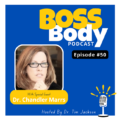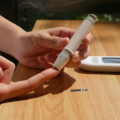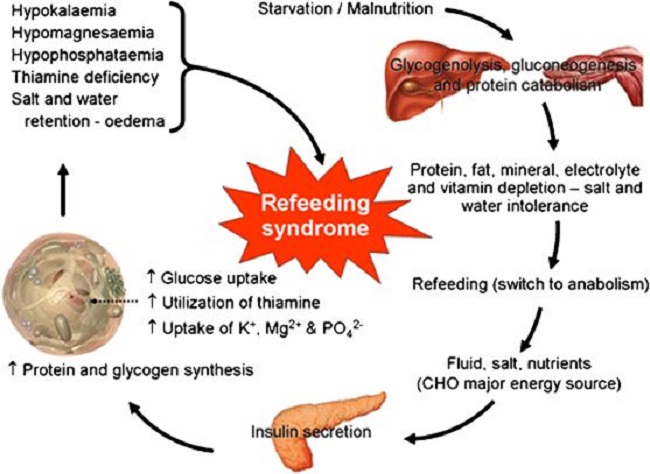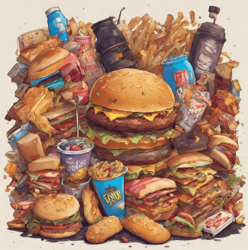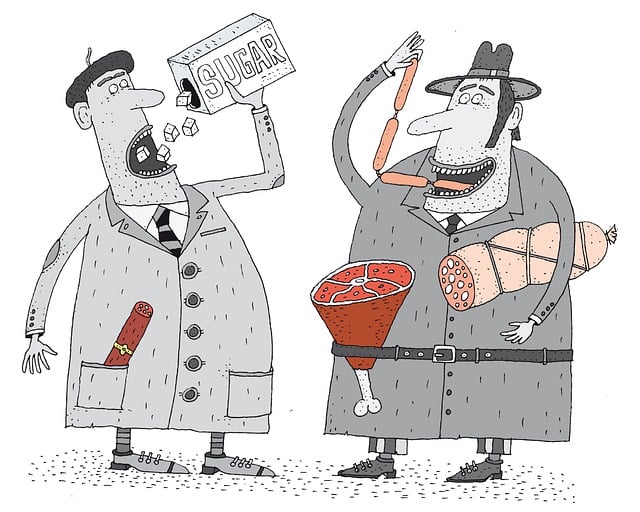I seldom watch television but for some reason nearly every time I do, the same commercial pops up. It goes something like this: a couple of women are sitting on a bench, chatting, when a guy walks up to them and asks if they have T2D (the answer is “yes”) and then he asks if they know that T2D can cause heart disease. The women act very surprised since they didn’t know. Why did they not know? And how come the pharmaceutical companies know that people don’t know? This commercial always makes me pause because it is so clear that we do not know what is happening to us.
We all know the scary statistics: the CDC admits that 9.3% of US adults are diagnosed with type 2 diabetes (T2D) as of 2010. The key word here is diagnosed. That is because more people are not diagnosed but have T2D than those who are diagnosed. It is estimated that over 30% of the population has T2D only they don’t know they have it. So one must ask a few questions:
- Why do so many Americans have T2D?
- Why don’t so many Americans know that they have T2D?
- What causes T2D?
- How does T2D start, why, and when?
- Can T2D be prevented?
- Can T2D be reversed or at least put to remission?
So let me be the one who tries to explain. The topic is not easy to explain so I am breaking it up into several parts, each at a different level of depth. In part 1 of this series, I will begin by discussing what nutrients are and how they connect to T2D. This will help explain why so many Americans do not know they have T2D and why they remain undiagnosed.
What Are You Eating?
If you look at what is sold in grocery stores today, you will find that over 80% of the stores are filled with commercially prepared foods: cereals, breads, canned foods, frozen pre-cooked foods, juices, soft drinks, candy, dried fruits, health bars, potato or veggie chips, crackers, popcorn, cooking oils, sugar, flour, prepared lunch meals, etc. Fresh dairy, meat, seafood, poultry, and fresh produce represent 10%, and toiletries, kitchen supplies, healthcare products, supplements, and sometimes cosmetics and greeting cards are the remaining 10%. The prices seem to be inversely related to the percentage these occupy in the store. Food-like products that are commercially processed are the cheapest, while fresh produce, dairy, and fresh meat are often prohibitively expensive. Thus, as budget allows, we end up buying a bunch of prepared foods; not only are they cheaper, they are also more convenient. In today’s busy world, who doesn’t want precooked foods that only require re-heating? What a time saver! Indeed, not a health-saver though. The money we save on food will end up in the pockets of medical institutions and pharmaceuticals for healthcare later, because most commercially prepared foods will make us sick.
Unfortunately, the cheapest and most readily available foods contribute most to type 2 diabetes. This takes a little explanation, so I am breaking foods down into the basic nutrient groups; macronutrients. There are three macronutrients: carbohydrates, protein, and fats. Because so many people don’t know what food falls into what macronutrient category, let me help you; some of the foods really aren’t obvious where they belong.
Protein
In our minds, protein refers to meat or fish though a small amount of protein is found in most every food item; even lettuce, only too small to matter. More protein is found in whole foods like unprocessed meats and fish than in processed foods like sausages or hot dogs. Protein is essential, meaning we must eat protein to survive. Proteins are made up of amino acids that form some of the most important macronutrient elements in our body. Protein is not just important for body building but it is essential for our brain and body to function and to survive.
There are a number of amino acids that are nonessential—meaning the body can create them–and others are essential–meaning we must eat them because our body cannot create them. All nonessential amino acids convert only to glucose, some essential amino acids convert to ketones only and some essential amino acids convert to either glucose or ketones based on dietary need. Over 50% of the amino acids convert to glucose. Glucose is in the family of carbohydrates, another macronutrient.
Carbohydrates
The largest nutrient group in most Americans’ life is carbohydrates. Carbohydrates are nonessential nutrients, meaning we can live perfectly healthy lives without a bite of carbohydrates. There is nothing in carbohydrates our body cannot make or we cannot eat in protein. Carbohydrates include the following foods (short list here): candy, sugar of all types (including honey), fruits, vegetables, legumes, nuts, seeds, grains, all foods sweetened with sugar like cookies, pastries, juices, and all natural vegetables, fruits, nuts, legumes, seeds, and alcohol. Carbohydrates are made from starches, glucose, fructose, lactose, and galactose. For example, most fruits contain glucose and fructose, most vegetables have glucose or some have starches (potatoes and carrots contains a lot of starch), milk has lactose, nuts are mostly glucose, and grains are glucose and starches. Although fiber is categorized as a carbohydrate, fiber is not used by the human body; it simply gets eliminated, so I exclude it from this category.
The key factor to know is that all carbohydrates convert to glucose (or to fructose and that partly converts to glucose). The speed with which they convert to glucose makes some difference but ultimately they all become glucose. Starches convert to glucose in our mouths before we swallow them even if they are not sweet (this includes whole wheat bread as well). Since protein is essential and over 50% of protein converts to glucose, carbohydrates become nonessential since we can make glucose without them. Carbohydrates play the biggest role in T2D because they provide excess glucose we don’t need. Although there is genetic predisposition to T2D as well, even those who are genetically so predisposed can prevent T2D by avoiding carbohydrates.
Fats
The third macronutrient group is fats. Fats represent the only nutrient that do not, under normal circumstances, convert to glucose. Fat remains fat. Fat is an essential nutrient in our body made of fatty acids, all of which are essential: omega 3 and omega 6.
From the three macronutrients, carbohydrates is the only one that poses a problem for insulin management and lack of proper insulin management leads to T2D.
How Do We Get T2D?
While most people think that T2D is the start of the problem, in reality it is the outcome, and thus, the end of the problem. There are many ways one can look at the progression to T2D. Most medical professionals (and the general population at large) think that people with T2D are obese. This is far from the truth and this causes the biggest problem in diagnosis. I think the confusion comes from the lack of understanding the progression toward T2D.
T2D starts when a person is thin and knows/cares very little about what she eats. The cause for T2D is too much insulin in response to excess glucose, that cannot be delivered to the liver. Though this sounds simple, it is complex enough to get many confused even in the field of medicine. We must ask a few questions:
- Where does excess glucose come from?
- Where does excess insulin come from?
- Why is insulin not able to pick glucose up from the blood and deliver it to the liver?
Understanding the Liver and Insulin
- Insulin is a signaling hormone for many functions, including packaging glucose into the liver for storage. Thus insulin is a storage hormone. Without insulin, people cannot gain weight—a typical problem for type 1 diabetics (T1D) who lack insulin production. T1Ds need to use insulin injections in order to survive, and gain and maintain healthy weight.
- Since insulin is a storage hormone, it automatically implies that it stores whatever food we were not able to immediately burn. This is healthy. Think of hibernating bears; they fatten up all summer and then in the winter hibernation they live off of the accumulated energy stored as fat. The key to their health is that they don’t eat during hibernation–meaning all year long. In contrast, humans continue to eat and store excess energy all year long.
- Once the storage cabinet of our body has reached its comfortable limit (the liver is our storage cabinet), insulin cannot pack more glucose into it. The liver refuses insulin’s attempts. This is called insulin resistance.
- Prediabetes and insulin resistance are the same phenomenon at different stages. Prediabetes usually occurs in people who already have insulin resistance.
- During insulin resistance, the excess glucose and the excess insulin circulate in the blood causing damage. They damage arteries by causing inflammation1 increasing blood pressure as a result, and can cause nerve damage (in the brain as well as in the body). Diabetic neuropathy starts at the stage of insulin resistance for many people and not at a later stage when T2D developed, which is how it is always portrayed.
- Insulin resistance is compartmentalized—meaning one may have insulin resistance in one organ (such as the liver) but not in another. This makes insulin resistance very hard to diagnose with conventional tests. The most typical test is the hemoglobin A1c (HbA1c), which measures the average amount of glucose the person had in his blood for a period of two to three months.
- Alzheimer’s disease is the insulin resistance (or type 3 diabetes) of the brain but not the body. Hence, the first sign of Alzheimer’s disease is the disease itself and not insulin resistance. This further shows the difficulty of diagnosing insulin resistance.
- During the start of insulin resistance, as more and more insulin is released to carry the glucose into the liver that cannot handle any more, the liver becomes ill with non-alcoholic fatty live disease. It makes the liver bigger, inflamed, and less able to do its job, which is the detoxification of the blood.
Since we feel none of this as pain or illness, nearly 100% of the people with insulin resistance have no idea that they have insulin resistance! As insulin resistance continues over decades being undetected, the body slowly degrades in its ability to fight back. Finally, when it is time, T2D arrives. By the time T2D is diagnosed, most people (not all) are overweight, because of the preceding years of insulin resistance that went unnoticed.
Manifestations of Insulin Resistance
Insulin resistance is not felt by anyone (the pain in the legs may be diagnosed as something else) and so its diagnosis is usually accidental and often inaccurate2,3. The tools used to check for insulin resistance, in the US and elsewhere, require one to be obese or pregnant with gestational diabetes risk. This presents a major problem since obesity tends to develop only after years of insulin resistance. An individual may have insulin resistance at age 11 and not know about it until at age 35, when she suddenly develops neuropathy with hurting feet, or gets shaky and dizzy if the food is five minutes late on her table. The achy feet are often misdiagnosed as a pinched nerve, Plantar fasciitis, or fibromyalgia. If you are ravenously hungry before breakfast and must eat every 3 hours, chances are pretty high you are have insulin resistance, even if you are paper thin, exercise a lot, even at the level of an athlete, and have no aches and pains.
There are two ways insulin resistance can be manifested and there is a bit of confusion in categorizing them so here I cap them under one roof: insulin resistance. The most common is simply being hungry very often with correspondingly high blood sugar—one can use a blood sugar measuring kit (finger poke) to test. This type of insulin resistance is hyperinsulinemia, which only lets itself be known by frequent hunger when the blood sugar levels are still high. The body’s ideal blood sugar level is <100 mg/gL and a healthy individual will not feel hungry while the blood sugar level is at or above 100 mg/dL. A typical hyperinsulinemic person feels hunger pangs at blood sugar of over 110 mg/dL. Normal blood sugar is defined as 70 – 140 mg/dL.
The hardest to treat insulin resistance is reactive hypoglycemia. Its manifestation is feeling shaky, dizzy, cold sweaty, feeling nauseous, whose blood sugar drops below the pre-meal starting blood sugar very shortly after eating. A typical hypoglycemic may start eating with pre-meal blood sugar of 90 mg/dL, an hour after finishing the meal may end up with 70 mg/dl, and an hour and a half later she may drop to 60 mg/dL. The level of glucose in the blood is closely regulated for its healthy minimum. Below 70 mg/dL, the body is in trouble so consider it a major warning. Below 60 mg/dL call the paramedics immediately. Below 50 mg/dL you may be dead—so don’t wait!
Can Insulin Resistance Be Prevented?
Yes it can. Since insulin resistance is too much insulin in response to high dietary glucose (glucose spikes insulin), if you stop eating those foods that give instant glucose access (see the glycemic index of foods), or more glucose than your body needs in general, you can reverse insulin resistance. Examples of foods to avoid include: all sweets with any shape or color, sugar, raw or otherwise, honey, etc., all foods sweetened with sweeteners of any kind (including sugar substitutes and naturals since they may also cause health problems, including obesity and T2D4), all juices whether they are sweetened or not, all smoothies and shakes whether they are sweetened or not, all tropical fruits and 90% of other fruits, all vegetables grown below the ground (like potatoes and carrots), peanuts, cereals, pseudo cereals (like quinoa), rice, corn, starches used in place of flour, all breads and pastas of all grain types, including whole grain or whole seed, oats, in general all grains, fermented alcohols, and legumes.
For some people dairy is also insulinogenic but not for all so I am not including dairy on the list. Stop eating all of the high glucose spiking foods listed above and increase animal fats, meats, eggs, and dark green leafy veggies in your diet, and you will be able to prevent insulin resistance.
So what can you eat when you cut out all these great tasting “foods” from your diet? Once you understand that these are really not foods but conveniences, you can see the replacements: increase green leafy vegetables in your diet; eat only those fruits we associate with vegetables: zucchini, bell peppers, squashes, tomatoes, cucumbers, and alike or low carbohydrate veggies like broccoli and cauliflower. Consume only raspberries, blackberries, and strawberries as your fruits with an occasional small orange or if must a very small serving of cantaloupe. Avoid all other fruit. Increase healthy dairy with full fat in your diet, use animal fats for cooking since vegetable oils are unhealthy and can be harmful. More details on the types on fats in part 2 of this series. Animal fats are butter, ghee, pork lard (buy pure pork lard and the not hydrogenated types available in grocery stores), beef tallow, bacon drippings (save it in a ceramic container–no refrigeration needed), poultry fat is super too.
Can Insulin Resistance be Reversed?
One of my migraine group members in the keto mild for migraine group had reactive hypoglycemia–that is the insulin resistance that is harder to treat. I asked her to switch to the zero carbs diet for a short time, after which she wrote the following:
“So looking back Aug 31st was my last low blood sugar [reactive hypoglycemia] day, yay! I followed Angela Stanton’s advice and did the zero carbs program for 6 days; I have reintroduced carbs back now, up to almost my norm for the ketogenic diet and still no low blood sugar!! I’m ecstatic! I have the bruised fingertips as proof of all the poking (I was actually eye spying my toes as an alternative ☺️) for me the increase in protein was the key. I realized I was not eating enough before. So for those of you struggling with reactive hypoglycemia this is the answer.” –LM 9/6/2017
As you can see, she reversed her reactive hypoglycemia by cutting all carbohydrates out of her diet for 6 days, and ate only protein and fat. Why does the zero carbs diet work? This and the rest of the information about nutrition and T2D are going to be discussed in the second part of the series on diabetes. So stay tuned and look for part 2!
Sources:
- Dandona P, Chaudhuri A, Ghanim H, Mohanty P. Proinflammatory Effects of Glucose and Anti-Inflammatory Effect of Insulin: Relevance to Cardiovascular Disease. American Journal of Cardiology.99(4):15-26.
- Kraft J, R;. Diabetes Epidemic &You. revision 1 ed. North America & International: Trafford; 2011.
- Crofts C, Schofield G, Zinn C, Wheldon M, Kraft J. Identifying hyperinsulinaemia in the absence of impaired glucose tolerance: An examination of the Kraft database. Diabetes Research and Clinical Practice.118:50-57.
- Shearer J, Swithers SE. Artificial sweeteners and metabolic dysregulation: Lessons learned from agriculture and the laboratory. Reviews in Endocrine and Metabolic Disorders 2016; 17(2): 179-86.
We Need Your Help
More people than ever are reading Hormones Matter, a testament to the need for independent voices in health and medicine. We are not funded and accept limited advertising. Unlike many health sites, we don’t force you to purchase a subscription. We believe health information should be open to all. If you read Hormones Matter, like it, please help support it. Contribute now.
Yes, I would like to support Hormones Matter.
Image created using Canva AI.

